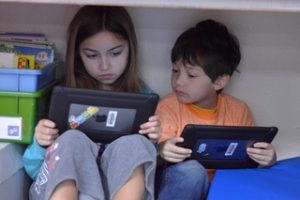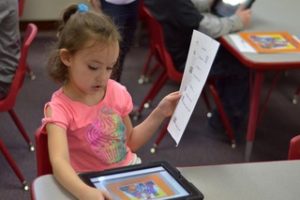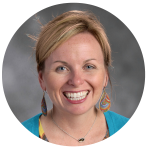 “You do what in kindergarten?!” is a common question I hear when asked about how we are redesigning Woodson Kindergarten Center (#WoodsonK) in Austin, Minnesota, with the early learner in mind. As principal of a school serving more than 400 ki ndergarten students, over twenty home languages, and has a growing number of students qualifying for free or reduced-price lunch, leading intentionally and equitably is critical.
“You do what in kindergarten?!” is a common question I hear when asked about how we are redesigning Woodson Kindergarten Center (#WoodsonK) in Austin, Minnesota, with the early learner in mind. As principal of a school serving more than 400 ki ndergarten students, over twenty home languages, and has a growing number of students qualifying for free or reduced-price lunch, leading intentionally and equitably is critical.
Integrating technology with the nation’s youngest learners is a delicate process that must be done intentionally and using more than one tool. This becomes a challenge when looking at incorporating activities and devices that enhance learning rather than replacing it with passive games in front of a computer screen. Finding the right tools for the extension of learning is best suited to be determined by teachers. The Future Ready Schools® (FRS) framework assessment identifies that “teachers are provided the resources and support needed to redesign classrooms into twenty-first-century learning environments.” This has significantly changed our way of looking at learning—for both students and adults.
 Each of the sixteen classrooms at #WoodsonK has iPads for student and staff use. Walking into a classroom, you may see students working together solving math problems in small groups, another student making a video to upload their learning onto Seesaw for the teacher to review later, and the classroom teacher or paraprofessional working one on one with a child assessing Fastbridge, which is a tool that collects formative assessment data on academic and social-emotional learning. Another group of students may be using the interactive display boards. These reflect teacher-created lessons that small groups of students engage in while the teacher is in the back of the room working with a different group of students observing and informally assessing the learning happening up in the front of the room.
Each of the sixteen classrooms at #WoodsonK has iPads for student and staff use. Walking into a classroom, you may see students working together solving math problems in small groups, another student making a video to upload their learning onto Seesaw for the teacher to review later, and the classroom teacher or paraprofessional working one on one with a child assessing Fastbridge, which is a tool that collects formative assessment data on academic and social-emotional learning. Another group of students may be using the interactive display boards. These reflect teacher-created lessons that small groups of students engage in while the teacher is in the back of the room working with a different group of students observing and informally assessing the learning happening up in the front of the room.
At #WoodsonK, a technology integrationist is in dedicated play centers two days a week to co-teach with the classroom teacher. Together, they plan and implement challenges that align with the monthly curriculum map and utilize technology to enhance the learning of concepts. In this environment, you may see students creating towers with Magna Tiles, blocks, and Legos and then taking pictures of their work. Teachers may be observing a group of students using a BeeBot to see if they can accurately program the robot to navigate numbers 21–14 backward on the grid. Another group of students may be testing their theories of states of matter at the water table and then discussing results while their teacher posts the video to their class Facebook site for parents to see.
 Technology should not be the barrier but rather the bridge for creative collaboration. At #WoodsonK, the Coding Club works with a class of second-grade students across the state to complete challenges created for each other. Teachers from #WoodsonK and an elementary school in Iowa City, Iowa, collaborate via Google Hangouts to prepare for the Global Read Aloud project. Much of the staff development at #WoodsonK has a flipped component to it, supporting our abilities to see the power of these tools in enhancing professional learning as adults.
Technology should not be the barrier but rather the bridge for creative collaboration. At #WoodsonK, the Coding Club works with a class of second-grade students across the state to complete challenges created for each other. Teachers from #WoodsonK and an elementary school in Iowa City, Iowa, collaborate via Google Hangouts to prepare for the Global Read Aloud project. Much of the staff development at #WoodsonK has a flipped component to it, supporting our abilities to see the power of these tools in enhancing professional learning as adults.
In the #WoodsonK classrooms that use technology such as Remind or Facebook, there is 98–100 percent participation by family members. Some families may not have computers at home, but they all have a Smartphone. Using this technology, we post videos, links to activities, and articles that help parents understand the critical learning occurring today in the early years. Leveraging technology in this way enhances what we already know in early learning: parents are a child’s first teacher. The more parents are involved, engaged, and support learning, the better for all #WoodsonK students.
At #WoodsonK, we work every day to innovate practices to meet the needs of tomorrow leaders today in our school. Is it unconventional at times? Yes. But it is essential to ensure our students today are Future Ready tomorrow.
ABOUT JESSICA CABEEN
 Jessica Cabeen has been principal of Woodson Kindergarten Center in Austin, Minnesota, since 2011. In 2016, she was awarded the National Association of Elementary School Principals/VINCI Education Digital Leader of Early Learning Award. In 2017, she was awarded the Minnesota National Distinguished Principal in 2017. Ms. Cabeen is a facilitator of the Minnesota Principals Academy at the University of Minnesota as well as a facilitator of the Minnesota P3 Leadership Series. She presents at conferences and workshops on topics such as early learning, PBIS (positive behavioral intervention and supports), professional learning communities, family engagement, and regain balance in personal and professional aspects of life. Follow Ms. Cabeen on Twitter at @JessicaCabeen and #WoodsonK and #PackInTrain.
Jessica Cabeen has been principal of Woodson Kindergarten Center in Austin, Minnesota, since 2011. In 2016, she was awarded the National Association of Elementary School Principals/VINCI Education Digital Leader of Early Learning Award. In 2017, she was awarded the Minnesota National Distinguished Principal in 2017. Ms. Cabeen is a facilitator of the Minnesota Principals Academy at the University of Minnesota as well as a facilitator of the Minnesota P3 Leadership Series. She presents at conferences and workshops on topics such as early learning, PBIS (positive behavioral intervention and supports), professional learning communities, family engagement, and regain balance in personal and professional aspects of life. Follow Ms. Cabeen on Twitter at @JessicaCabeen and #WoodsonK and #PackInTrain.
